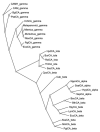May Sulfonamide Inhibitors of Carbonic Anhydrases from Mammaliicoccus sciuri Prevent Antimicrobial Resistance Due to Gene Transfer to Other Harmful Staphylococci?
- PMID: 36430304
- PMCID: PMC9693918
- DOI: 10.3390/ijms232213827
May Sulfonamide Inhibitors of Carbonic Anhydrases from Mammaliicoccus sciuri Prevent Antimicrobial Resistance Due to Gene Transfer to Other Harmful Staphylococci?
Abstract
Mammaliicoccus sciuri, previously known as Staphylococcus sciuri, is a Gram-positive bacterium involved in gene transfer phenomena that confer resistance to multiple antibiotics. These plasmid-encoded genes can be easily transferred to other pathogenic staphylococci. Because antibiotic resistance is rising, inhibiting M. sciuri proliferation may be a credible strategy for restricting antimicrobial resistance gene transfer to other pathogenic bacteria. Recently, it has been shown that blocking bacterial carbonic anhydrases (CAs, EC 4.2.1.1), metalloenzymes sustaining bacterial metabolic activities, can reduce pathogen survival and fitness. Here, the recombinant M. sciuri γ-CA (MscCAγ) has been cloned and purified, utilizing the DNA recombinant technology. Its kinetic properties for the CO2 hydration reaction, as well as the sulfonamide inhibition profile, were investigated and compared with those reported earlier for MscCAβ (previously described as SauBCA) and the two off-target human CA isoforms (hCA I and hCA II). The recombinant MscCAγ showed significant hydratase activity. Moreover, the MscCAγ sulfonamide inhibitory profile was different from that of MscCAβ, implying that a varied amino acid set typifies the catalytic pocket of the two enzymes. These differences provide additional evidence for the possibility of developing novel CA class-specific inhibitors.
Keywords: antibacterials; antimicrobial resistance; carbonic anhydrase; inhibitors; sulfonamides.
Conflict of interest statement
The authors declare no conflict of interest.
Figures





Similar articles
-
Inhibition studies with simple and complex (in)organic anions of the γ-carbonic anhydrase from Mammaliicoccus (Staphylococcus) sciuri, MscCAγ.J Enzyme Inhib Med Chem. 2023 Dec;38(1):2173748. doi: 10.1080/14756366.2023.2173748. J Enzyme Inhib Med Chem. 2023. PMID: 36719031 Free PMC article.
-
An overview of novel antimicrobial carbonic anhydrase inhibitors.Expert Opin Ther Targets. 2023 Jul-Dec;27(10):897-910. doi: 10.1080/14728222.2023.2263914. Epub 2023 Oct 30. Expert Opin Ther Targets. 2023. PMID: 37747071 Review.
-
Sulfonamide inhibition studies of the γ-carbonic anhydrase from the Antarctic bacterium Pseudoalteromonas haloplanktis.Bioorg Med Chem Lett. 2015 Sep 1;25(17):3550-5. doi: 10.1016/j.bmcl.2015.06.079. Epub 2015 Jul 3. Bioorg Med Chem Lett. 2015. PMID: 26174556
-
The Effect of Substituted Benzene-Sulfonamides and Clinically Licensed Drugs on the Catalytic Activity of CynT2, a Carbonic Anhydrase Crucial for Escherichia coli Life Cycle.Int J Mol Sci. 2020 Jun 11;21(11):4175. doi: 10.3390/ijms21114175. Int J Mol Sci. 2020. PMID: 32545297 Free PMC article.
-
Inhibition of Bacterial Carbonic Anhydrases as a Novel Approach to Escape Drug Resistance.Curr Top Med Chem. 2017;17(11):1237-1248. doi: 10.2174/1568026617666170104101058. Curr Top Med Chem. 2017. PMID: 28049405 Review.
Cited by
-
Sulphonamide inhibition studies of the β-carbonic anhydrase GsaCAβ present in the salmon platyhelminth parasite Gyrodactylus salaris.J Enzyme Inhib Med Chem. 2023 Dec;38(1):2167988. doi: 10.1080/14756366.2023.2167988. J Enzyme Inhib Med Chem. 2023. PMID: 36647786 Free PMC article.
-
Progress of Section "Biochemistry" in 2022.Int J Mol Sci. 2023 Mar 20;24(6):5873. doi: 10.3390/ijms24065873. Int J Mol Sci. 2023. PMID: 36982946 Free PMC article.
-
Exploration of Aromatic Hydrazides as Inhibitors of Human Carbonic Anhydrases.Arch Pharm (Weinheim). 2025 Apr;358(4):e202400963. doi: 10.1002/ardp.202400963. Arch Pharm (Weinheim). 2025. PMID: 40165649 Free PMC article.
-
Novel thiazolone-benzenesulphonamide inhibitors of human and bacterial carbonic anhydrases.J Enzyme Inhib Med Chem. 2023 Dec;38(1):2163243. doi: 10.1080/14756366.2022.2163243. J Enzyme Inhib Med Chem. 2023. PMID: 36629426 Free PMC article.
-
Discovery of the first-in-class potent and isoform-selective human carbonic anhydrase III inhibitors.J Enzyme Inhib Med Chem. 2023 Dec;38(1):2202360. doi: 10.1080/14756366.2023.2202360. J Enzyme Inhib Med Chem. 2023. PMID: 37092262 Free PMC article.
References
MeSH terms
Substances
Supplementary concepts
Grants and funding
LinkOut - more resources
Full Text Sources

